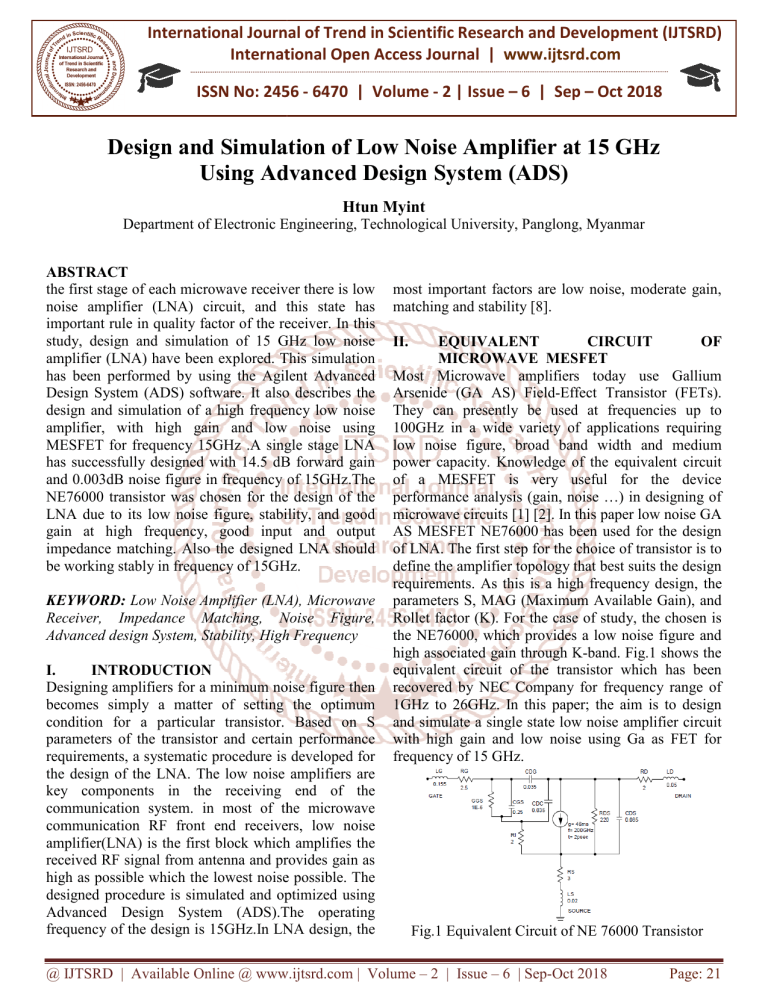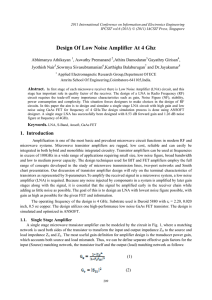
International Journal of Trend in Scientific Research and Development (IJTSRD)
International Open Access Journal | www.ijtsrd.com
ISSN No: 2456 - 6470 | Volume - 2 | Issue – 6 | Sep – Oct 2018
Design and Simulation of Low Noise Amplifier at 15 GHz
Using Advanced Design Syst
System (ADS)
Htun Myint
Department of Electronic Enginee
Engineering, Technological University, Panglong
long, Myanmar
ABSTRACT
the first stage of each microwave receiver there is low
noise amplifier (LNA) circuit, and this state has
important rule in quality factor of the receiver. In this
study, design and simulation of 15 GHz low noise
amplifier (LNA) have been explored. This simul
simulation
has been performed by using the Agilent Advanced
Design System (ADS) software. It also describes the
design and simulation of a high frequency low noise
amplifier, with high gain and low noise using
MESFET for frequency 15GHz .A single stage LNA
has successfully designed with 14.5 dB forward gain
and 0.003dB noise figure in frequency of 15GHz.The
NE76000 transistor was chosen for the design of the
LNA due to its low noise figure, stability, and good
gain at high frequency, good input and output
impedance
nce matching. Also the designed LNA should
be working stably in frequency of 15GHz.
KEYWORD: Low Noise Amplifier (LNA), Microwave
Receiver, Impedance Matching, Noise Figure,
Advanced design System, Stability, High Frequency
I.
INTRODUCTION
Designing amplifiers for a minimum noise figure then
becomes simply a matter of setting the optimum
condition for a particular transistor. Based on S
parameters of the transistor and certain performance
requirements, a systematic procedure is developed for
the design of the LNA. The low noise amplifiers are
key components in the receiving end of the
communication system. in most of the microwave
communication RF front end receivers, low noise
amplifier(LNA) is the first block which amplifies the
received RF signal from antenna and provides gain as
high as possible which the lowest noise possible. The
designed procedure is simulated and optimized using
Advanced Design System (ADS).The operating
frequency of the design is 15GHz.In
In LNA design
design, the
most important
ant factors are low noise, moderate gain,
g
matching and stability [8].
EQUIVALENT
CIRCUIT
OF
MICROWAVE MESFET
Most Microwave amplifiers today use Gallium
Arsenide (GA AS) Field-Effect
Effect Transistor (FETs).
They can presently be used at frequencies up to
100GHz in a wide variety of applications requiring
low noise figure, broad band width and medium
power capacity. Knowledge of the equivalent circuit
of a MESFET is very useful for the device
performance analysis (gain, noise …) in designing of
microwave circuits [1] [2]. In this paper low noise GA
AS MESFET NE76000 has been used for the design
of LNA. The first step for the choice of transistor is to
define the amplifier topology that best suits the design
requirements.
uirements. As this is a high frequency design, the
parameters S, MAG (Maximum Available Gain),
Gain) and
Rollet factor (K). For the case of study, the chosen is
the NE76000, which provides a low noise figure and
high associated gain through K-band.
K
Fig.1 shows the
equivalent circuit of the transistor which has been
recovered by NEC Company for frequency range of
1GHz to 26GHz. In this paper; the aim is to design
and simulate a single state low noise amplifier circuit
with high gain and low noise using Ga as FET for
frequency of 15 GHz.
II.
Fig.1 Equivalent Circuit of NE 76000 Transistor
@ IJTSRD | Available Online @ www.ijtsrd.com | Volume – 2 | Issue – 6 | Sep-Oct 2018
Page: 21
International Journal of Trend in Scientific Research and Development (IJTSRD) ISSN: 2456
2456-6470
III.
Then the overall transducer gain is GT=GS’GoGL.
The effective gains from GS and GL are due to the
impedance matching of the transistor to the
impedance Z0.
DC BIASING
Table.1 LNA Requirements
Parameters
specification
cification
Operating frequency
15GHz
Bias Point
Vd=3v,Ids=10mA
Technology
Ga As MESFET
Gain
>14.4
Noise Figure
<1
Fig.2 the General Transistor Amplifier Circuit
In order to design a low noise device, the transistor
must be DC biased at an appropriate operating point.
These depends of the application (low noise
noise, high
gain, high power), and the type of the transistor ((FET,
HFET, etc) [4].
The circuit is designed to meet the chosen biasing,
considering that very high values of resistance
naturally add more noise to the system, and very low
resistance
esistance increase the power consumption of the
system. Accounts both source and load mismatch.
Thus from [6],can be separate effective gain factors
for the input (source) matching network, the transistor
itself and the output (load) matching network as
follow.
Vd (drain voltage) =3V and Ids (drain-Source
Source current)
=10mA.This biasing point is obtained by using a Vg
(gate voltage) range from -0.6 to 3 V [5].
5].
A. Single Stage Amplifier
A single stage amplifier microwave transistor
amplifier can be modeled by the circuit in Fig.2,
where a matching network is used both sides of the
transistor to transform the input and output impedance
Z0 to the source and load impedance Zs and ZL. The
most useful gain definition for amplifier design is the
transducer power gain,, which accounts both source
and load mismatch. Thus from[6], can be defined
separate effective gain factors for the input (source)
matching network, the transistor itself and output
(load) matching network
As follow:
G =
'
s
GL =
1− ΓS
2
1 − Γ IN Γ S
1 − ΓL
2
(1)
2
(2)
2
1 − S 22 Γ L
B. Stability Consideration
The stability of an amplifier,
amplifier or its resistance to
oscillate, is a very important consideration in a design
and can be determined from the S parameters, the
matching networks, and the terminations. In the
circuit, oscillations are possible when
w
either the input
or output port presents a negative resistance. This
occurs when Γ IN >1 or ΓOUT >1.These because of Γ IN
and ΓOUT depend on the source and load matching
networks. While, the stability of the amplifier depends
on Γ S and Γ L as presented
sented by the matching
networks, when starting on any amplifier design it is
very important to
o spend time checking on the stability
of the device chosen, otherwise the amplifier may
well turn into an oscillator. The main way of
determining the stability of a device is to calculate the
Rollett’s stability factor(K), which is calculate using a
set of S-parameters
parameters for the device at the frequency of
operation. Alternatively, it can be shown that
amplifier will be unconditionally stable if the
following necessary and sufficient conditions are met
[7].
K =
1 − S 11
2
− S 22
2
+ ∆S
2
2 S 21 . S 12
>1
(3)
∆ <1
K=1.393
C. Matching Network Design
The need for matching network arises because
amplifiers, in order to deliver maximum power to a
load, or to perform in a certain desired way, must be
properly terminated at both the input and output
outp port.
Several types of matching network are available,
however factors
ors likes complexity, bandwidth,
bandwidth
implementation and adjustability need to be
considered in the matching network seletion. The
amplifier could be matched for a variety of conditions
such as low noise applications, unilateral case and
bilateral case. The impedance matching networks can
be designed either mathematically or graphically.
@ IJTSRD | Available Online @ www.ijtsrd.com | Volume – 2 | Issue – 6 | Sep-Oct 2018
Page: 22
International Journal of Trend in Scientific Research and Development (IJTSRD) ISSN: 2456-6470
2456
IV.
NOISE
FIGURES
SIMULATION
RESULT
The minimum noise figure is needed in order to
achieve the maximum gain.Fig.3 Show the minimum
noise figure plot. The Lowest Fm in 0.004 dB
obtained at frequency 15GHz.
Fig.5 S12 Parameter Plot
Fig.3 Minimum Noise Figure
V.
EXPERIMENTAL RESULT
The designed LNA with matching network at 15GHz
was obtained. The forward gain (S21), isolation (S12),
S11 and S22 plot is shown in figures. The results shows
that the S11 <1 and S22 <1 full fills the stability
condition.
Fig.6 S21 Parameter Plot
The highest forward gain (S21)is 14.49dB at 15GHz as
shown in Fig.6.The design LNA also shows a good
isolation when S12 value is below -50dB
50dB at 15GHz.
Also the stability factor, K=1.393 plot is shown in
Fig.8.Thus the design LNA should be working stably
in frequency of 15GHz.
Fig.7 S22 Parameter Plot
Fig.4 S11 Parameter Plot
Fig.8 Stability Factor K Plot
@ IJTSRD | Available Online @ www.ijtsrd.com | Volume – 2 | Issue – 6 | Sep-Oct 2018
Page: 23
International Journal of Trend in Scientific Research and Development (IJTSRD) ISSN: 2456-6470
2456
4. Microwave Engineering--David M-Pozar. John
Wiley &Sons. INC-New
New York.
York Chichester.
Weinheim. Brisbane-Singapore.
Singapore. Toronto.
VI.
CONCLUSION
In this paper, LNA at 15 GHz for microwave receiver
system have been designed and simulated. It is
observed that the forward gain and noise figure of
these designs is almost 14.49 dB and 0.004 dB
respectively in 15GHz.This simulation result have
good assent with desired demand.
5. Agilent Technologies (2000).”Application No to
1190-Low
Low Noise Amplifier for 900MHz using the
Agilent ATF-34143.Low
34143.Low Noise PHEMT”.USA:
Agilent Technologies 1-8.
VII. REFERENCES
1. C.A BAL anis,, Antenna Theory: Analysis and
design, Harper and Row N. Y.,, 1982
1982.
6. D.M Pozar (2000). ”Microwave RF Wireless
System”, United State of America: John Wiley
and sons Inc 77797, 205-207.
207.
2. K. Miyauchi, “Millimeter-Wave Communi
Communication,
“in Infrared and millimeter waves, vol. 9, K. J.
Button, ED, Academic pres, N. Y.,, 1983
1983.
7. Microwave Transistor Amplifier
Amplifi Analysis and
Design Guillermo Gonzalez,
Gonzalez Ph.D.1984 by
Prentice-Hall, Inc Englewood Cliffs, New Jersey
07632.
3. Exclusive North America Agent for NEC RF,
Microwave &optoelectronic semiconductors CEL
California Eastern Laboratories--Headquarters4590 Parick Heny Drive, Santaa clora, CA 95054
950541817-www.CEL.com.
8. Mohd. Zinol Abidin Abd Aziz (2004),”Low Noise
Amplifier Circuit Design for 5GHz to 6GHz”,
Proceeding of the 2004 IEEE-0-7083-8671-X/04/IEEE
RF and microwave
crowave conference, October 5-6,
Subang, Selangor, Malasia. 81300skudia, Johor,
Malaysia will be deleted from the biography.
Fig.9 Input and Output Matching Network Of designed LNA
@ IJTSRD | Available Online @ www.ijtsrd.com | Volume – 2 | Issue – 6 | Sep-Oct 2018
Page: 24



